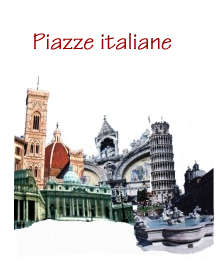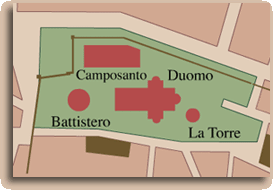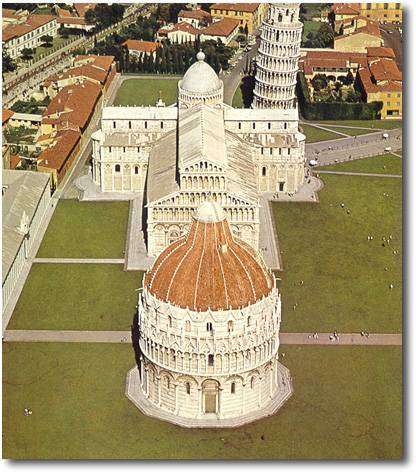
PIAZZA DEI MIRACOLI
The tower of Pisa is the bell
tower of the Cathedral. Its construction began on August 1173 and continue
( with two long interruptions) for about two hundred years, in full
fidelity to the original project, whose architect is still uncertain. In the past it was widely believed that the inclination of the Tower
was part of the project ever since its beginning , but now we know that
it is not so. The Tower was designed to be "vertical"(and even if it
did not lean it would stile be one of the most remarkable bell towers
in Europe), and started to incline during its construction. Both because
of its inclination and its beauty from1173 up to the present the tower
has been the object of very special attention. During its construction
efforts were made to halt the incipient inclination through the use
of special construction devices ; later columns and other damaged parts
were substituted in more than one occasion today, interventions are
being carried out within the sub soil in order to significantly reduce
the inclination and to make sure that Tower will have a long life. In
all this story it is possible to find a meaningful constant, the "genetic
code" of the Tower: its continual interaction with the soil on which
it was built. Today's works for the safeguard and the conservation of
the Tower with very advanced methodologies are designed to fully respect
this constant. Leaving to one side the celebrated inclination - that
daring challenge to the laws of statics - the bell tower of the Cathedral
is a unique building of its kind, both for its great art historical
value and for its peculiar situation, in the context of the vast and
similarly unique area known as Piazza dei Miracoli. The Tower occupies
a site to one side of the Cathedral, between the apsidal area and the
south-eastern portion of the transept of the latter. Though not an isolated
case (similar spatial organisations can be found in some Pisan complexes
and in other Italian buildings), this is an unusual collocation: normally,
bell towers were built near to the fašade or along one side of churches.
Here, however, the Tower assumes an unusual value through its dislocation
from the other monuments in the area of Piazza dei Miracoli. This road,
which ran towards the apse and alongside the northern side of the Cathedral,
continued beyond the city walls, through which it passed via the so-called
porta de Leone - the Gate of the Lion. Furthermore, the contiguity between
the Tower and the apsidal area of the Cathedral established a formal
dialogue between the two buildings. The Tower, with its great height,
was a visual fulcrum, visible from all areas of the Piazza, and, probably,
from the river Arno. In this way the Tower assumed the function of both
connection between the city and the piazza, sited in a decentralised
area of the urban nucleus, and beacon: a reference point and look-out
and, ultimately, an authoritative symbol of the civic and religious
pride of the Pisan community.
In the past it was widely believed that the inclination of the Tower
was part of the project ever since its beginning , but now we know that
it is not so. The Tower was designed to be "vertical"(and even if it
did not lean it would stile be one of the most remarkable bell towers
in Europe), and started to incline during its construction. Both because
of its inclination and its beauty from1173 up to the present the tower
has been the object of very special attention. During its construction
efforts were made to halt the incipient inclination through the use
of special construction devices ; later columns and other damaged parts
were substituted in more than one occasion today, interventions are
being carried out within the sub soil in order to significantly reduce
the inclination and to make sure that Tower will have a long life. In
all this story it is possible to find a meaningful constant, the "genetic
code" of the Tower: its continual interaction with the soil on which
it was built. Today's works for the safeguard and the conservation of
the Tower with very advanced methodologies are designed to fully respect
this constant. Leaving to one side the celebrated inclination - that
daring challenge to the laws of statics - the bell tower of the Cathedral
is a unique building of its kind, both for its great art historical
value and for its peculiar situation, in the context of the vast and
similarly unique area known as Piazza dei Miracoli. The Tower occupies
a site to one side of the Cathedral, between the apsidal area and the
south-eastern portion of the transept of the latter. Though not an isolated
case (similar spatial organisations can be found in some Pisan complexes
and in other Italian buildings), this is an unusual collocation: normally,
bell towers were built near to the fašade or along one side of churches.
Here, however, the Tower assumes an unusual value through its dislocation
from the other monuments in the area of Piazza dei Miracoli. This road,
which ran towards the apse and alongside the northern side of the Cathedral,
continued beyond the city walls, through which it passed via the so-called
porta de Leone - the Gate of the Lion. Furthermore, the contiguity between
the Tower and the apsidal area of the Cathedral established a formal
dialogue between the two buildings. The Tower, with its great height,
was a visual fulcrum, visible from all areas of the Piazza, and, probably,
from the river Arno. In this way the Tower assumed the function of both
connection between the city and the piazza, sited in a decentralised
area of the urban nucleus, and beacon: a reference point and look-out
and, ultimately, an authoritative symbol of the civic and religious
pride of the Pisan community.
Authors: Fabio, Stefano Fa.
